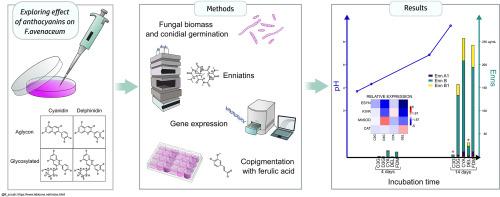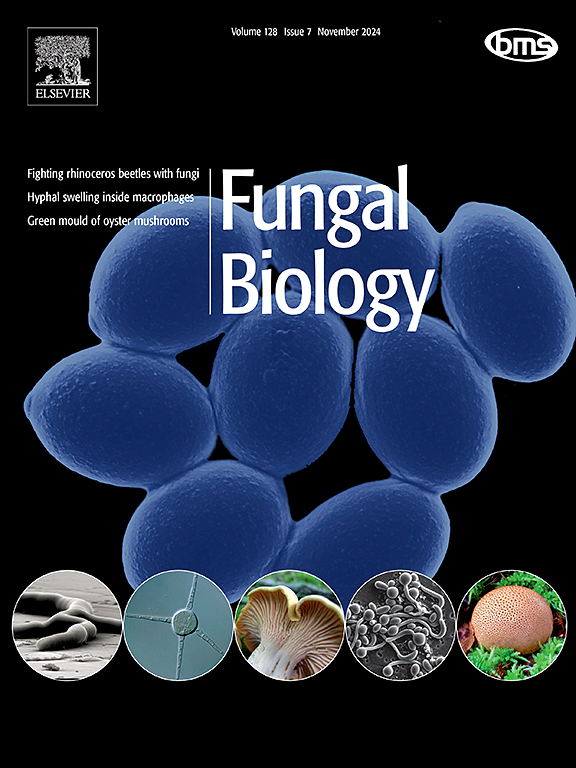花青素- 3- o -葡萄糖苷和其他花青素影响镰刀菌多年生素的产生
IF 3
3区 生物学
Q2 MYCOLOGY
引用次数: 0
摘要
赤霉病(Fusarium Head Blight, FHB)是由多种镰刀菌引起的,是全球谷物生产的主要威胁。avenaceum是一种重要的FHB病原菌,产生嫩芽素真菌毒素。虽然一些研究已经探索了不同酚类化合物的抗真菌和抗真菌毒素的潜力,但花青素(植物中丰富的色素,包括某些谷物)的作用仍然知之甚少。本研究探讨了花青素对avenaceum孢子萌发、真菌生物量和多年生产物产量的影响。体外实验表明,花青素(花青素、飞鸽苷)抑制孢子萌发,花青素3- o -葡萄糖苷和飞鸽苷3- o -葡萄糖苷增加真菌生物量。值得注意的是,花青素3- o -葡萄糖苷和飞鸽苷一致地降低了nial - ins的产量(A1, B和B1),而飞鸽苷3- o -葡萄糖苷主要降低了nial - ins A1。这些不同的效果可能归因于糖基化部分的存在或缺失,不同的降解途径,以及花青素对真菌基因表达的影响,包括参与叶青素生物合成和氧化稳态的关键基因的调节。此外,研究还考察了花青素3- o -葡萄糖苷和阿魏酸(另一种植物酚类化合物)的协同作用。当阿魏酸与花青素3- o -葡萄糖苷联合使用时,阿魏酸稳定花青素3- o -葡萄糖苷,保持其抗霉菌毒素活性,而阿魏酸的抗真菌潜力被取消,突出了这些化合物之间复杂的相互作用。这些发现为花青素作为天然抗真菌毒素药物的潜力提供了有价值的见解,并建议优化其用于真菌毒素控制。本文章由计算机程序翻译,如有差异,请以英文原文为准。

Cyanidin 3-O-glucoside and other anthocyanins affect enniatins production in Fusarium avenaceum
Fusarium Head Blight (FHB), caused by various Fusarium species, is a major threat to global cereal production. F. avenaceum is an important FHB pathogen producing enniatin mycotoxins. While several studies have explored the antifungal and anti-mycotoxigenic potential of different phenolic compounds, the effects of anthocyanins (pigments abundant in plants including certain cereals) remain poorly understood. This study explored the effects of anthocyanins on F. avenaceum conidial germination, fungal biomass and enniatins production. In vitro assays revealed that while anthocyanidins (cyanidin, delphinidin) inhibited conidial germination, cyanidin 3-O-glucoside and delphinidin 3-O-glucoside increased fungal biomass. Notably, cyanidin 3-O-glucoside and delphinidin consistently reduced enniatins production (A1, B and B1), whereas delphinidin 3-O-glucoside primarily reduced enniatin A1. These contrasting effects can likely be ascribed to presence or absence of the glycosylated moiety, distinct degradation pathways, and the influence of anthocyanins on fungal gene expression, including the regulation of key genes involved in enniatin biosynthesis and oxidative homeostasis. Furthermore, the study examined the concurrent effects of cyanidin 3-O-glucoside and ferulic acid, another plant phenolic compound. When combined, ferulic acid stabilized cyanidin 3-O-glucoside, preserving its anti-mycotoxin activity, while antifungal potential of ferulic acid was abrogated, highlighting the complex interactions between these compounds. These findings provide valuable insights into the potential of anthocyanins as natural anti-mycotoxin agents and suggest an optimization of their use for mycotoxin control.
求助全文
通过发布文献求助,成功后即可免费获取论文全文。
去求助
来源期刊

Fungal biology
MYCOLOGY-
CiteScore
5.80
自引率
4.00%
发文量
80
审稿时长
49 days
期刊介绍:
Fungal Biology publishes original contributions in all fields of basic and applied research involving fungi and fungus-like organisms (including oomycetes and slime moulds). Areas of investigation include biodeterioration, biotechnology, cell and developmental biology, ecology, evolution, genetics, geomycology, medical mycology, mutualistic interactions (including lichens and mycorrhizas), physiology, plant pathology, secondary metabolites, and taxonomy and systematics. Submissions on experimental methods are also welcomed. Priority is given to contributions likely to be of interest to a wide international audience.
 求助内容:
求助内容: 应助结果提醒方式:
应助结果提醒方式:


